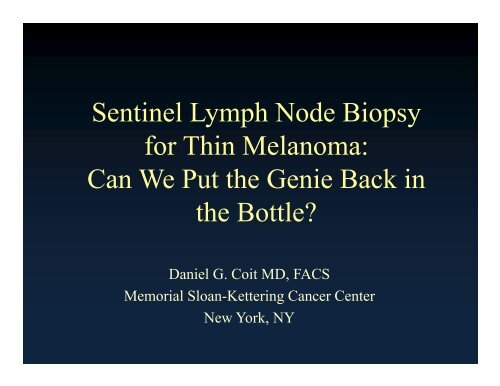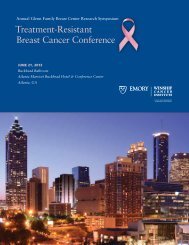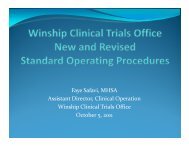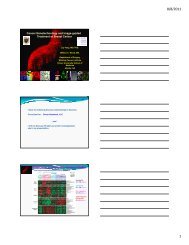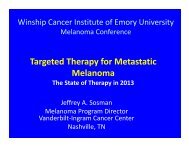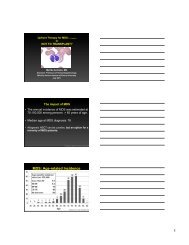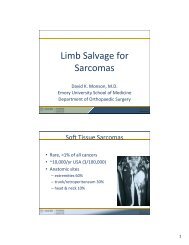Sentinel Lymph Node Biopsy for Thin Melanoma - Winship Cancer ...
Sentinel Lymph Node Biopsy for Thin Melanoma - Winship Cancer ...
Sentinel Lymph Node Biopsy for Thin Melanoma - Winship Cancer ...
Create successful ePaper yourself
Turn your PDF publications into a flip-book with our unique Google optimized e-Paper software.
<strong>Sentinel</strong> <strong>Lymph</strong> <strong>Node</strong> <strong>Biopsy</strong><br />
<strong>for</strong> <strong>Thin</strong> <strong>Melanoma</strong>:<br />
Can We Put the Genie Back in<br />
the Bottle<br />
Daniel G. Coit MD, FACS<br />
Memorial Sloan-Kettering <strong>Cancer</strong> Center<br />
New York, NY
SLNB in thin melanoma<br />
Concepts<br />
• Probability vs threshold<br />
– Probability: MD defined<br />
– Threshold: Patient defined<br />
• Clinical utility<br />
– Cost/benefit analysis<br />
– Multifactorial
SLNB <strong>for</strong> thin melanoma<br />
<strong>Thin</strong> melanoma<br />
Number of patients presenting to MSKCC <strong>for</strong> primary<br />
treatment of melanoma by thickness, 1997-2003<br />
1800<br />
1600<br />
1400<br />
1200<br />
1000<br />
800<br />
600<br />
400<br />
200<br />
0<br />
1654<br />
55% of all patients<br />
649<br />
411<br />
294<br />
< 1 mm 1-2 mm 2-4 mm > 4mm<br />
Thickness MSKCC, 2004
SLNB in thin melanoma<br />
Nodal relapse in thin melanoma<br />
Institution U Penn JWCI<br />
Period 1996-2004 1971-2005<br />
Patients 882 1732<br />
Median<br />
follow-up<br />
Nodal<br />
relapse<br />
16.4 years 13.2 years<br />
31 (3.5%) 50 (2.9%)<br />
Independent<br />
predictors<br />
of nodal<br />
relapse<br />
Ulceration P=0.002<br />
Mitotic rate > 0 P=0.003<br />
VGP present P=0.009<br />
Male gender P=0.01<br />
Male gender P
SLNB in thin melanoma<br />
Nodal relapse in thin melanoma<br />
Nodal relapse by Breslow thickness<br />
Nodal relapse nomogram<br />
Faries MB, Arch Surg 2010; 145(2):137-42
SLNB in melanoma<br />
SLNB in thin melanoma<br />
• Meta-analysis of 3651 patients with thin melanoma<br />
undergoing SLNB, from 34 studies.<br />
• Positive SLN found in 5% of patients.<br />
• 14 studies reported results of CLND in 1135<br />
patients<br />
– One patient had a positive NSLN<br />
• 14 studies reported recurrence and survival<br />
– 6/8 patients with recurrence had melanomas ≥ 0.75 mm<br />
– 8 studies reported no melanoma related deaths<br />
Warycha MA, <strong>Cancer</strong> 2009; 115:869-79
SLNB <strong>for</strong> thin melanoma<br />
<strong>Thin</strong> melanoma<br />
• 223 patients with thin melanoma<br />
(< 1 mm ) underwent WE with<br />
SLNB at MSKCC.<br />
• Patient and tumor related data<br />
were analyzed <strong>for</strong> predictors of<br />
SLNB positivity.<br />
• Prognostic significance of<br />
positive SLN was analyzed.<br />
Wong S, Ann Surg Oncol; 2006, 13(3):1-8
SLNB <strong>for</strong> thin melanoma<br />
<strong>Thin</strong> melanoma<br />
Factors predictive of (+) SLN<br />
Clinicopathologic characteristic<br />
p-value<br />
Age (continuous) 0.74<br />
Gender 0.89<br />
Site of primary (extremity, trunk, head and neck) 0.37<br />
Thickness (continuous) 0.74<br />
Clark level (II, III, IV) 0.26<br />
Ulceration 0.33<br />
Regression 0.16<br />
Tumor infiltrating lymphocytes (brisk, minimal, none/unk) 0.40<br />
Mitotic rate (high, low, unknown) 0.07<br />
Number of involved nodal basins (single, multiple) 0.62<br />
Wong S, Ann Surg Oncol; 2006, 13(3):1-8
SLNB <strong>for</strong> thin melanoma<br />
<strong>Thin</strong> melanoma<br />
(+) SLN biopsy N (%)<br />
< 1.0 mm thickness (n=223) 8/223 (3.6%)<br />
< 0.75 mm thickness (n=73) 0/73 (0%)<br />
0.75 – 1.0 mm thickness (n=150) 8/150 (5.3%)<br />
Clark level II/III (n=70) 0/70 (0%)<br />
Clark level IV (n=150) 8/150 (5.3%)<br />
0.75 – 1.0 mm thickness AND Clark level IV (n=114) 8/114 (7%)<br />
All patients with + SLN underwent completion<br />
lymphadenectomy; no patient had disease beyond the SLN<br />
Wong S, Ann Surg Oncol; 2006, 13(3):1-8
SLNB <strong>for</strong> thin melanoma<br />
<strong>Thin</strong> melanoma – probability of + SLN<br />
Author Year N + SLN % Survival<br />
Statius Muller 2001 104 7 6.7% NA<br />
Rousseau 2003 388 16 4.1% NA<br />
Borgognoni 2004 114 2 1.8% NA<br />
Stitzenberg 2004 146 6 4.1% NA<br />
Puleo 2005 409 20 4.9% NA<br />
Kesmodel 2005 181 9 5.0% NA<br />
Kruper 2006 251 13 5.2% NA<br />
Thompson 2006 187 9 4.8% NA<br />
Ranieri 2006 184 12 6.5% P=0.01 on UVA (one death)<br />
Cascinelli 2006 145 6 4.1% NA<br />
Nowecki 2006 260 17 6.5% NA<br />
Wong 2006 223 8 3.6% P=NS on UVA<br />
Wright 2008 631 31 5.0% P
SLNB <strong>for</strong> thin melanoma<br />
<strong>Thin</strong> melanoma – probability of + SLN<br />
Author Year + SLN
SLNB <strong>for</strong> thin melanoma<br />
<strong>Thin</strong> melanoma – probability of + SLN<br />
Author Year N Clark Ulcer MR VGP Regres TIL Gender Age<br />
Bedrosian 2000 71 Y<br />
Bleicher 2003 272 N N N N N N<br />
Jacobs 2003 63 N<br />
Olah 2003 89 N N N Y<br />
Oliveira 2003 77 N Y Y Y<br />
Sondak 2004 42 Y Y<br />
Stitzenberg 2004 146 N N N N N<br />
Kesmodel 2005 181 N N Y N N<br />
Puleo 2005 409 N N<br />
Ranieri 2006 184 Y N Y N N N<br />
Hershko 2006 64 N N N<br />
Wong 2006 223 N N N N N N N<br />
Taylor 2007 135 Y<br />
Cecchi 2008 59 N<br />
Wright 2008 631 Y N Y Y<br />
Yonick 2011 147 N Y N N N N N N<br />
Murali 2012 432 N N N N N N<br />
Studies identifying factor 2/12 2/12 4/8 2/6 1/7 1/4 1/7 2/10
SLNB <strong>for</strong> thin melanoma<br />
<strong>Thin</strong> melanoma - outcome after SLNB<br />
Wong S, Ann Surg Oncol; 2006, 13(3):1-8
SLNB <strong>for</strong> thin melanoma<br />
<strong>Thin</strong> melanoma - outcome after SLNB<br />
<strong>Melanoma</strong>-specific survival according to the nodal status after wide local excision and sentinel<br />
lymph node biopsy in patients with thin primary cutaneous melanoma<br />
631 patients with melanomas ≤1 mm<br />
thick underwent WE/SLNB at JWCI<br />
Negative SLN - 600<br />
Positive SLN - 31 (5%)<br />
Median f/u 57 months<br />
Wright, BE, Arch Surg 2008;143:892
SLNB <strong>for</strong> thin melanoma<br />
NCCN guidelines
SLNB <strong>for</strong> thin melanoma<br />
NCCN guidelines <strong>for</strong> SLNB<br />
Thickness<br />
(mm)<br />
Mitotic rate Ulceration Adverse factors*<br />
1.0-4.0 Offer Offer Offer Offer Offer Offer<br />
> 4.0 Offer Offer Offer Offer Offer Offer<br />
* Adverse features include + margin, LVI, Clark IV
SLNB <strong>for</strong> thin melanoma<br />
Cost of SLNB in thin melanoma<br />
• 120 patients with thin melanoma undergo SLNB<br />
• Six patients (5%) will have a positive SLN<br />
– All will be offered CLND; none will have a + NSLN<br />
– All will be considered <strong>for</strong> adjuvant therapy<br />
– All will be considered <strong>for</strong> baseline/follow-up imaging<br />
– All will be followed closely <strong>for</strong> recurrence<br />
• Of the six patients with a positive SLN<br />
– One (15%) will die and five (85%) will survive
SLNB <strong>for</strong> thin melanoma<br />
Cost of SLNB in thin melanoma<br />
• If the incremental charge rendered <strong>for</strong> SLNB<br />
alone is $10,000, then, excluding charges<br />
associated with CLND, adjuvant therapy and<br />
more intensive followup <strong>for</strong> those patients with<br />
a positive SLN, the cost to identify one excess<br />
unpreventable death from melanoma =<br />
$10,000 x 120 = $1,200,000
SLNB <strong>for</strong> thin melanoma<br />
Cost of SLNB in thin melanoma<br />
Among the six patients with a positive SLN<br />
ALL WILL WORRY!!
SLNB in thin melanoma<br />
Concepts – clinical utility of SLNB<br />
Intrinsic value <strong>for</strong> patient<br />
Direct clinical care<br />
Impact on recurrence<br />
Impact on survival<br />
Stratify <strong>for</strong> clinical trials<br />
Financial cost<br />
Of SLNB procedure<br />
If SLN positive:<br />
Imaging<br />
Frequent follow-up<br />
Adjuvant therapy<br />
Morbidity<br />
SLNB<br />
CLND<br />
Psychological stress<br />
Variable predictive value<br />
Insurability<br />
Pro<br />
Con
SLNB <strong>for</strong> thin melanoma<br />
Summary<br />
• The probability of a positive SLN in patients<br />
with thin melanoma is around 5%.<br />
• The most reliable predictor of a positive SLN in<br />
patients with thin melanoma is primary tumor<br />
thickness.<br />
– ≤ 0.75 mm 2.5%<br />
– 0.76-1.0 mm 7%<br />
• There is no consensus as to what other risk<br />
factors predict a positive SLN in thin melanoma.
SLNB <strong>for</strong> thin melanoma<br />
Summary<br />
• A positive SLN in patients with thin melanoma<br />
is prognostically significant:<br />
– A positive SLN is associated with a 12-25%<br />
worse survival.<br />
– The survival difference may not be apparent<br />
<strong>for</strong> five years or more.<br />
• The financial cost of identifying one<br />
unpreventable death by per<strong>for</strong>ming SLNB on<br />
all patients with thin melanoma is prohibitive.
SLNB <strong>for</strong> thin melanoma<br />
Summary<br />
• We have a rudimentary understanding of the<br />
probability of a positive SLN in patients with<br />
thin melanoma.<br />
• There is no consensus on a firm threshold of<br />
probability below which SLNB should not be<br />
per<strong>for</strong>med.<br />
• While a discussion of SLNB should be<br />
encouraged in all patients with melanoma, it<br />
should include recommendations on who<br />
should not undergo the procedure.
SLNB <strong>for</strong> thin melanoma<br />
Question 1<br />
• A 56 year old man presents to you <strong>for</strong> treatment<br />
of a changing mole on his back. Shave biopsy<br />
revealed a melanoma measuring 0.6 mm, Clark<br />
IV, non-ulcerated, with a mitotic rate of 2/mm 2 ,<br />
and a positive margin (in situ melanoma seen at<br />
the periphery). The probability of a positive<br />
SLN is:<br />
a) 1%<br />
b) 3%<br />
c) 5%<br />
d) 7%<br />
e) 10%
SLNB <strong>for</strong> thin melanoma<br />
Question 2<br />
• This patient was found to have a micrometastasis<br />
in 1/2 sentinel nodes (0.5 mm in subcapsular<br />
sinus, without extracapsular extension). He<br />
went on to completion LND with no further<br />
melanoma seen in 10 nodes examined. His<br />
probability of survival at 8 years is:<br />
a) 95%<br />
b) 80%<br />
c) 50%<br />
d) 30%<br />
e) 10%
SLNB <strong>for</strong> thin melanoma<br />
Question 3<br />
• If you had this man’s melanoma, and were<br />
found to have micrometastatic disease in 1/2<br />
sentinel nodes, what would you choose to do<br />
a) Cross sectional imaging<br />
b) Completion LND<br />
c) Adjuvant interferon<br />
d) a) and b)<br />
e) a) and c)<br />
f) b) and c)<br />
g) a) and b) and c)<br />
h) None of the above
SLNB <strong>for</strong> thin melanoma<br />
Question 4<br />
• Independent of how it is determined, your<br />
personal threshold of probability of finding a<br />
positive sentinel node that would persuade you to<br />
undergo SLNB is:<br />
a) 1%<br />
b) 3%<br />
c) 5%<br />
d) 7%<br />
e) 10%


